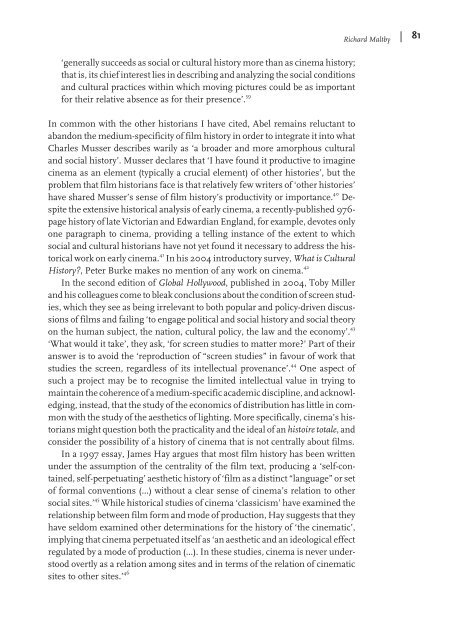Artikel: On the prospect of writing cinema history from below
Artikel: On the prospect of writing cinema history from below
Artikel: On the prospect of writing cinema history from below
Create successful ePaper yourself
Turn your PDF publications into a flip-book with our unique Google optimized e-Paper software.
Richard Maltby | 81‘generally succeeds as social or cultural <strong>history</strong> more than as <strong>cinema</strong> <strong>history</strong>;that is, its chief interest lies in describing and analyzing <strong>the</strong> social conditionsand cultural practices within which moving pictures could be as importantfor <strong>the</strong>ir relative absence as for <strong>the</strong>ir presence’. 39In common with <strong>the</strong> o<strong>the</strong>r historians I have cited, Abel remains reluctant toabandon <strong>the</strong> medium-specificity <strong>of</strong> film <strong>history</strong> in order to integrate it into whatCharles Musser describes warily as ‘a broader and more amorphous culturaland social <strong>history</strong>’. Musser declares that ‘I have found it productive to imagine<strong>cinema</strong> as an element (typically a crucial element) <strong>of</strong> o<strong>the</strong>r histories’, but <strong>the</strong>problem that film historians face is that relatively few writers <strong>of</strong> ‘o<strong>the</strong>r histories’have shared Musser’s sense <strong>of</strong> film <strong>history</strong>’s productivity or importance. 40 Despite<strong>the</strong> extensive historical analysis <strong>of</strong> early <strong>cinema</strong>, a recently-published 976-page <strong>history</strong> <strong>of</strong> late Victorian and Edwardian England, for example, devotes onlyone paragraph to <strong>cinema</strong>, providing a telling instance <strong>of</strong> <strong>the</strong> extent to whichsocial and cultural historians have not yet found it necessary to address <strong>the</strong> historicalwork on early <strong>cinema</strong>. 41 In his 2004 introductory survey, What is CulturalHistory?, Peter Burke makes no mention <strong>of</strong> any work on <strong>cinema</strong>. 42In <strong>the</strong> second edition <strong>of</strong> Global Hollywood, published in 2004, Toby Millerand his colleagues come to bleak conclusions about <strong>the</strong> condition <strong>of</strong> screen studies,which <strong>the</strong>y see as being irrelevant to both popular and policy-driven discussions<strong>of</strong> films and failing ‘to engage political and social <strong>history</strong> and social <strong>the</strong>oryon <strong>the</strong> human subject, <strong>the</strong> nation, cultural policy, <strong>the</strong> law and <strong>the</strong> economy’. 43‘What would it take’, <strong>the</strong>y ask, ‘for screen studies to matter more?’ Part <strong>of</strong> <strong>the</strong>iranswer is to avoid <strong>the</strong> ‘reproduction <strong>of</strong> “screen studies” in favour <strong>of</strong> work thatstudies <strong>the</strong> screen, regardless <strong>of</strong> its intellectual provenance’. 44 <strong>On</strong>e aspect <strong>of</strong>such a project may be to recognise <strong>the</strong> limited intellectual value in trying tomaintain <strong>the</strong> coherence <strong>of</strong> a medium-specific academic discipline, and acknowledging,instead, that <strong>the</strong> study <strong>of</strong> <strong>the</strong> economics <strong>of</strong> distribution has little in commonwith <strong>the</strong> study <strong>of</strong> <strong>the</strong> aes<strong>the</strong>tics <strong>of</strong> lighting. More specifically, <strong>cinema</strong>’s historiansmight question both <strong>the</strong> practicality and <strong>the</strong> ideal <strong>of</strong> an histoire totale, andconsider <strong>the</strong> possibility <strong>of</strong> a <strong>history</strong> <strong>of</strong> <strong>cinema</strong> that is not centrally about films.In a 1997 essay, James Hay argues that most film <strong>history</strong> has been writtenunder <strong>the</strong> assumption <strong>of</strong> <strong>the</strong> centrality <strong>of</strong> <strong>the</strong> film text, producing a ‘self-contained,self-perpetuating’ aes<strong>the</strong>tic <strong>history</strong> <strong>of</strong> ‘film as a distinct “language” or set<strong>of</strong> formal conventions (...) without a clear sense <strong>of</strong> <strong>cinema</strong>’s relation to o<strong>the</strong>rsocial sites.’ 45 While historical studies <strong>of</strong> <strong>cinema</strong> ‘classicism’ have examined <strong>the</strong>relationship between film form and mode <strong>of</strong> production, Hay suggests that <strong>the</strong>yhave seldom examined o<strong>the</strong>r determinations for <strong>the</strong> <strong>history</strong> <strong>of</strong> ‘<strong>the</strong> <strong>cinema</strong>tic’,implying that <strong>cinema</strong> perpetuated itself as ‘an aes<strong>the</strong>tic and an ideological effectregulated by a mode <strong>of</strong> production (...). In <strong>the</strong>se studies, <strong>cinema</strong> is never understoodovertly as a relation among sites and in terms <strong>of</strong> <strong>the</strong> relation <strong>of</strong> <strong>cinema</strong>ticsites to o<strong>the</strong>r sites.’ 46
















